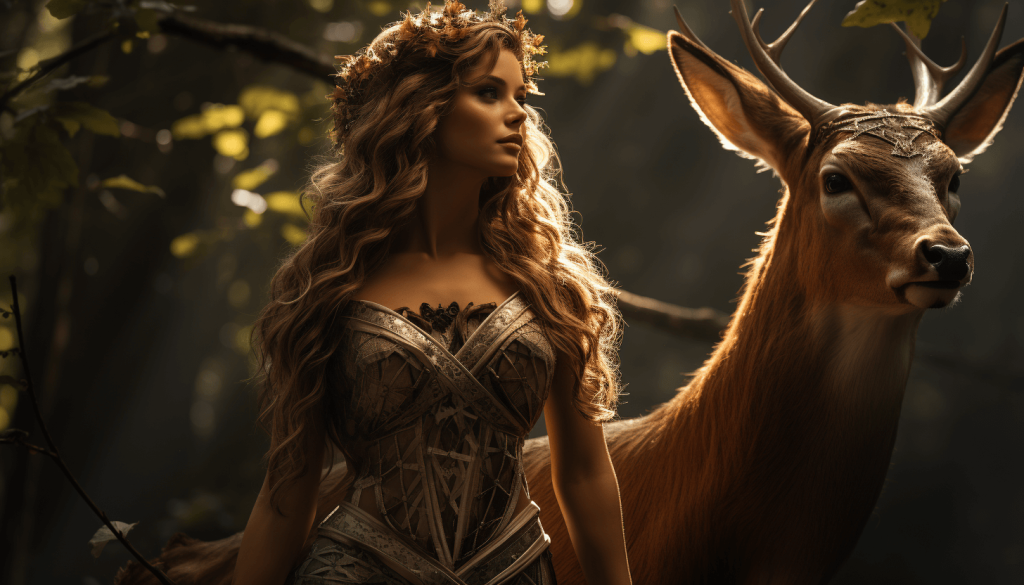Origins and Early Mythology: Tracing the Beginnings of Artemis
Artemis, with her fierce demeanor and silver bow, has long been a figure of intrigue and reverence in the annals of Greek mythology. But where did this powerful deity’s story commence?
Artemis, often synonymous with wilderness and the untamed lands, was the daughter of Zeus, the king of gods, and Leto, a Titaness. She was born on the island of Delos, making it a sacred place for her worshippers. Intriguingly, her birth was anything but ordinary.
The Birth of the Twin Deities
Artemis’s birth tale intertwines with that of her twin brother, Apollo. Hera, the queen of gods and Zeus’s wife, driven by jealousy towards Leto, forbade any land from offering her a place to give birth. However, Delos, being an unstable island and not “fixed” land, provided refuge to Leto.
- The Precocious Midwife: Legend states that Artemis was born first and, showcasing her divine attributes, immediately assisted her mother in delivering Apollo.
- The Island’s Reward: In gratitude, the twins secured Delos to the ocean floor, transforming it from a floating island to a stable haven.
The Evolution of Artemis’s Character
From her early tales, Artemis was not just a huntress. Her domain extended to encompassing the mysteries of nature. The moonlight filtering through dense forests? That was Artemis’s realm. The animals roaming wild and free? They were under her protection.
| Domains | Descriptions |
|---|---|
| Wild Animals | The beasts of the forests were Artemis’s companions and under her safeguard. |
| Virginity | Embodying purity and chastity, Artemis protected her own virtue and that of her followers. |
| Childbirth | Paradoxically, while being a virgin, Artemis was also considered a protector of women in childbirth, drawing from her experience during Apollo’s birth. |
To truly appreciate Artemis’s significance, one must delve into her foundational tales. These early stories don’t just chronicle her divine deeds, but they also paint a vivid picture of her character, values, and the multifaceted domains she ruled over.
Artemis is a central figure in Greek mythology, renowned as the goddess of the hunt. Daughter of Zeus and Leto, and twin sister to Apollo, her dominion extends to the moon, virginity, and childbirth. Often depicted with a bow and arrow, Artemis symbolizes independence, strength, and the natural world.
The Eternal Maiden: Understanding Artemis’s Vow of Chastity
In the vast tapestry of Greek mythology, few threads are as distinct and notable as the unyielding chastity of Artemis. Revered not only as the goddess of the hunt but also as the protector of the young and the guardian of purity, Artemis’s commitment to remain an eternal maiden stands out, offering profound insights into her character and the values she epitomizes.
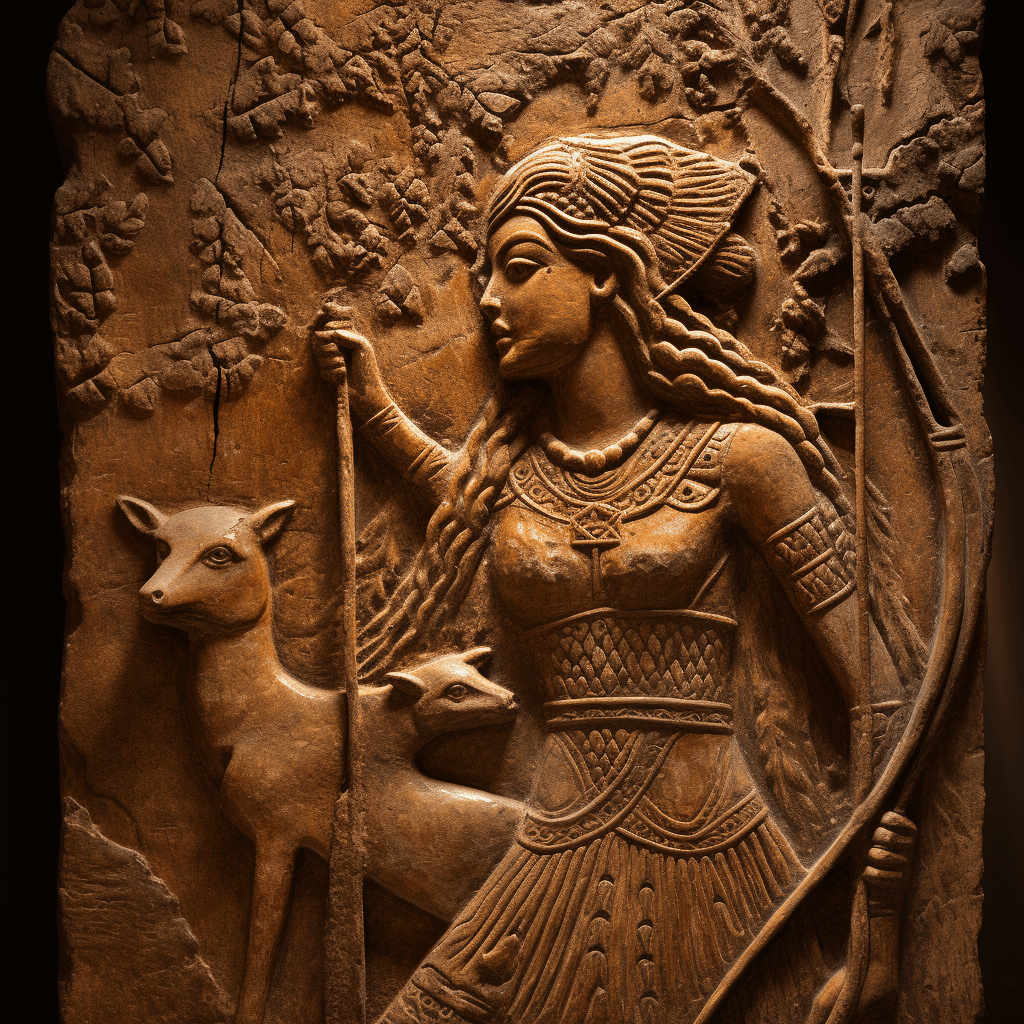
Why the Vow of Chastity?
From a tender age, Artemis knew the path she wished to tread. To ensure her autonomy, independence, and dedication to the wild, she made a solemn request to her father, Zeus: the boon of eternal virginity. Recognizing her unwavering conviction, Zeus granted her wish, allowing her to remain free from the romantic entanglements that often brought both joy and sorrow to other gods and mortals alike.
The Symbolism Behind the Vow
- Unyielding Focus: Artemis’s chastity mirrored her unerring focus on her duties. Without the distractions of love or partnership, she remained ever-committed to her role as a huntress and protector.
- Empowerment: Her choice to remain chaste was not about rejecting love but embracing her power, showcasing a divine form of feminism that challenged societal norms.
- Purity of Purpose: In a world where deities often had intertwined relationships, Artemis’s dedication to her vow highlighted a clear, untainted purpose and a devotion to her craft.
Artemis in Contrast
While other Olympian deities like Aphrodite and Hera were often embroiled in tales of passion and jealousy, Artemis remained apart, her narratives seldom touched by such intrigues. This difference not only accentuates her unique position among the gods but also underscores the ideals she represented: strength in autonomy and pride in one’s chosen path.
Understanding Artemis’s vow is paramount to comprehending her essence. In a pantheon teeming with powerful figures, she carved a niche for herself, shining brightly as a beacon of unwavering principle and purity.
Symbols of Artemis: The Bow, the Moon, and the Stag
In the intricate world of Greek mythology, symbols play a crucial role in encapsulating the essence of the gods, their tales, and the principles they embody. Artemis, the Goddess of the Hunt, is no exception. Through her emblematic symbols – the bow, the moon, and the stag – we gain a deeper understanding of her character, dominion, and influence.
The Bow: Mastery and Precision
Perhaps the most iconic symbol associated with Artemis is her bow. More than a mere weapon, the bow signifies her prowess as a huntress and her command over the wilderness. When one imagines Artemis, it’s often as a determined figure, bow in hand, eyes focused on a distant target. But why the bow? It’s a testament to her precision, her autonomy, and her ability to strike swiftly when needed. As a symbol, it embodies not just her role as a huntress but also her unerring focus and commitment to her duties and principles.
The Moon: Guardian of the Night
- Nurturing Luminescence: As the twin sister of Apollo, the sun god, Artemis took dominion over the moon. Its gentle glow contrasts with the blazing sun, reflecting Artemis’s role as a protector, especially of women and children. The moon, with its cycles and phases, also symbolizes the various facets of femininity and the mysteries of the natural world.
- Guidance in Darkness: The moon serves as a beacon in the night, guiding lost souls and hunters alike. In this capacity, it represents Artemis’s role as a guide, ensuring safe passage and protection to those under her watch.
The Stag: Grace and Vigilance
The stag, with its majestic antlers and graceful demeanor, is another symbol intrinsically linked to Artemis. In various tales, Artemis is often seen accompanied by golden-horned stags, signifying her deep connection to the wilderness and its creatures. But what does the stag represent? It’s a symbol of purity, agility, and vigilance. Just as a stag remains ever-alert to its surroundings, Artemis too is ever-vigilant, guarding the forests and their inhabitants. Moreover, its grace mirrors Artemis’s own elegance and poise, qualities that set her apart in the pantheon of Greek gods.
In understanding these symbols, we don’t just learn about objects or animals; we delve deeper into the psyche of the goddess they represent. They offer a lens, magnifying the traits, tales, and teachings of Artemis, helping us to appreciate her role and relevance in Greek mythology even more.
Artemis and Apollo: The Bond of the Divine Twins
In the rich tapestry of Greek mythology, relationships between deities shape narratives, principles, and lessons for humanity. One such dynamic, laden with mutual respect, competition, and deep-seated love, is the bond between Artemis, the Moon Goddess, and Apollo, the Sun God. As divine twins, their stories often intersect, providing us with insights into their individual characters and shared histories.
Birth and Early Years: United in Struggle
Artemis and Apollo were the children of Zeus and Leto. Due to Hera’s jealousy, Leto was forced to find a secluded place to give birth. With Artemis born first, an interesting aspect of their bond took root: despite being just hours old, Artemis assisted her mother in delivering her twin brother. This act not only showcases Artemis’s role as a guardian of childbirth but also the immediate connection between the siblings.
Shared Duties: Complementing Roles
While they had distinct domains – Artemis presiding over the wilderness and the moon, and Apollo governing music, arts, and the sun – their roles often complemented each other. This was especially evident in their shared duty of bringing sudden deaths: Artemis to women and Apollo to men. Together, they maintained the delicate balance of life and death, ensuring the harmony of the natural world.
- Protectors of the Young: Both deities had a soft spot for the young. While Artemis was known to watch over young girls, guiding them to adulthood, Apollo was seen as a guardian to young boys, mentoring them as they transitioned into men.
- Skilled Hunters: Artemis’s impeccable skill with the bow was matched by Apollo’s. Often, tales depict them hunting together, side by side, showcasing their seamless collaboration and mutual admiration.
Challenges and Conflicts: The Essence of Siblinghood
Yet, like all siblings, they had their moments of discord. Whether it was due to disagreements or challenges thrown at each other, these instances added depth to their relationship. An example is the tale of Orion, a giant huntsman. While the stories vary, in one version, Apollo, feeling threatened by Orion’s closeness to his sister, tricks Artemis into shooting him. Despite the conflict, it’s their reconciliation and continued bond that stands out.
In conclusion, the dynamic between Artemis and Apollo serves as a testament to the multidimensional nature of siblinghood. Through their tales, we are reminded of the joys, challenges, and enduring nature of the bond between brothers and sisters, making their stories ever relevant and relatable.
Major Myths Involving Artemis: Acts of Vengeance and Protection
The tapestry of Greek mythology is woven with tales of divine intervention, retribution, and salvation. Among its prominent threads are the tales of Artemis, the Goddess of the Hunt. With a fierce sense of protection over the natural world and the beings within her domain, Artemis was not one to be wronged. Here, we delve into some major myths where Artemis’s acts of vengeance and protection come to the fore, reflecting her multifaceted nature.
The Punishment of Actaeon
One of the most well-known myths involving Artemis is the tragic tale of Actaeon, a renowned hunter. Upon accidentally witnessing Artemis bathing in a secluded forest stream, he was transformed into a stag by the enraged goddess. Unable to communicate, Actaeon found himself pursued and eventually torn apart by his own hunting dogs, a dire consequence for a momentary trespass.
Protection of Niobe’s Remaining Children
Niobe, proud mother of fourteen, boasted about her children and belittled Leto, the mother of Artemis and Apollo, for having only two. In retaliation, Apollo and Artemis struck down Niobe’s children. However, in some versions of the tale, it’s believed that Artemis, in a fleeting moment of mercy, spared a few of Niobe’s daughters.
- Defense of Chione: Chione, a beautiful maiden, boasted that she surpassed Artemis in beauty. Instead of exacting vengeance on Chione herself, Artemis directed her wrath towards Chione’s mortal lovers, proving that while she was protective, she could also be vindictive.
- Orion’s End: Orion, a giant huntsman, shared a close bond with Artemis. However, due to varying circumstances across different myths, Artemis ends up causing his death. In one version, she’s tricked by Apollo, while in another, she’s forced to kill Orion to protect her vow of chastity.
Guardianship over the Vulnerable
Artemis’s protective nature wasn’t just reserved for moments of vengeance. She also played the role of a guardian. A poignant example is the story of the Aloadae giants. They sought to storm Mount Olympus, and during their assault, they kidnapped Artemis. However, instead of retaliating with violence, Artemis transformed herself into a doe, causing confusion and eventually leading to the giants’ downfall.
In the vast realm of Greek mythology, Artemis stands out as a deity who fiercely protects her domain and principles. Her tales, filled with both wrath and compassion, resonate with the duality of human nature, making her one of the most relatable and revered figures in ancient lore.
The Cult of Artemis: Temples, Worship, and Rituals
Artemis, with her multifaceted roles ranging from the protector of the wilderness to the guardian of young girls, occupied a significant place in ancient Greek religious practices. Her cult, widespread and diverse, witnessed myriad forms of worship, celebrated in various temples and through unique rituals. Delve with us into the world of Artemis’s worshipers and discover the grandeur and sanctity of her cult.
Temples Dedicated to Artemis
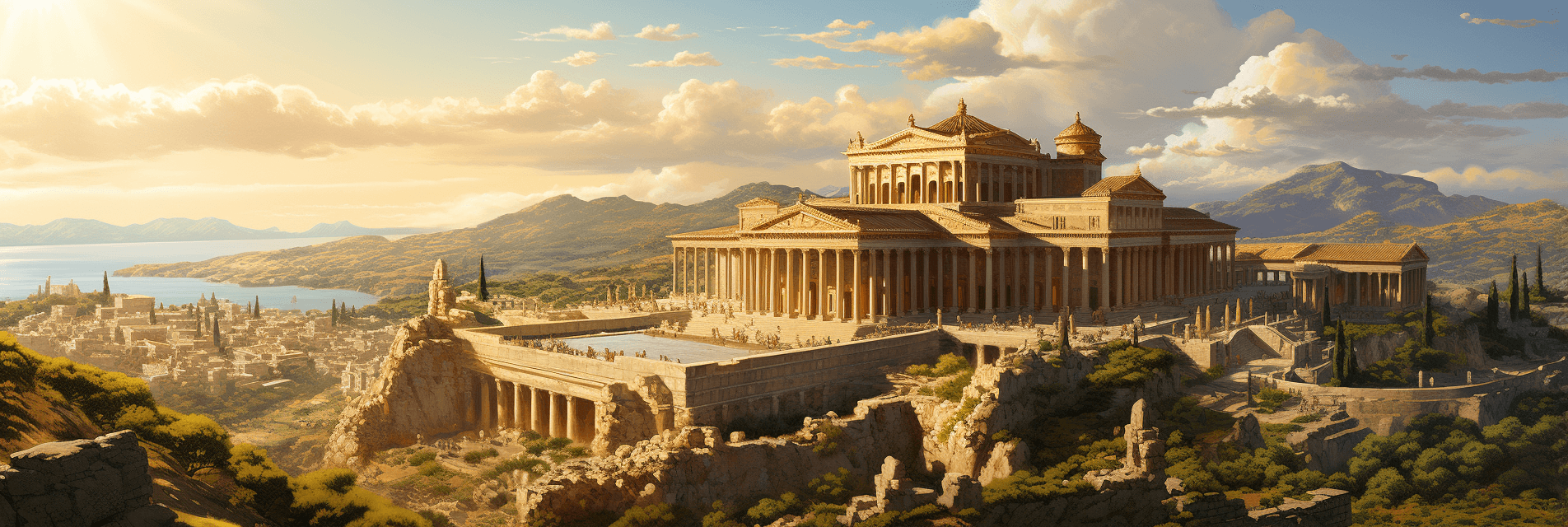
The architectural marvels dedicated to Artemis were not just places of worship but also epitomized the glory and reverence accorded to the goddess. Some of the most renowned temples include:
- The Temple of Artemis at Ephesus: One of the Seven Wonders of the Ancient World, this temple was not only an architectural masterpiece but also a major religious center.
- The Temple of Artemis Orthia: Located in Sparta, this temple was known for its unique rituals and was an integral part of Spartan religious practices.
- Artemis Brauronia Temple: Situated in Athens, it was a significant place of worship and a sanctuary for young Athenian girls.
Distinctive Rituals and Festivals
The worship of Artemis wasn’t confined to mere prayers. It encompassed a range of rituals and festivals, reflecting the diverse roles she played in the lives of her devotees.
| Ritual/Festival | Description |
|---|---|
| Brauronia | A festival celebrated in Brauron, young girls, representing bears, “played the bear” for Artemis, symbolizing the transition from childhood to adulthood. |
| Munychia | Commemorated in Athens, it celebrated Artemis as the protector of communities. Cakes shaped like the full moon were offered to honor her. |
| Taurian Artemis Festival | Held in Tauris, this festival is linked to the myth of Iphigenia and had, according to some accounts, human sacrifices as an integral part. |
The Significance of Worship
Why was Artemis so widely worshiped? The answer lies in her diverse roles. As the goddess of wilderness, she safeguarded nature and its beings. As the guardian of childbirth and young girls, she was invoked for protection and blessings. These diverse facets made her an indispensable figure in the spiritual and everyday lives of ancient Greeks.
In conclusion, the cult of Artemis provides a fascinating insight into the religious practices of ancient Greece. Her temples stood as testaments to her grandeur, while the rituals and festivals celebrated her diverse roles, making Artemis an enduring and revered figure in ancient Greek religion.
Artemis’s Companions: The Nymphs and Animals of the Wilderness
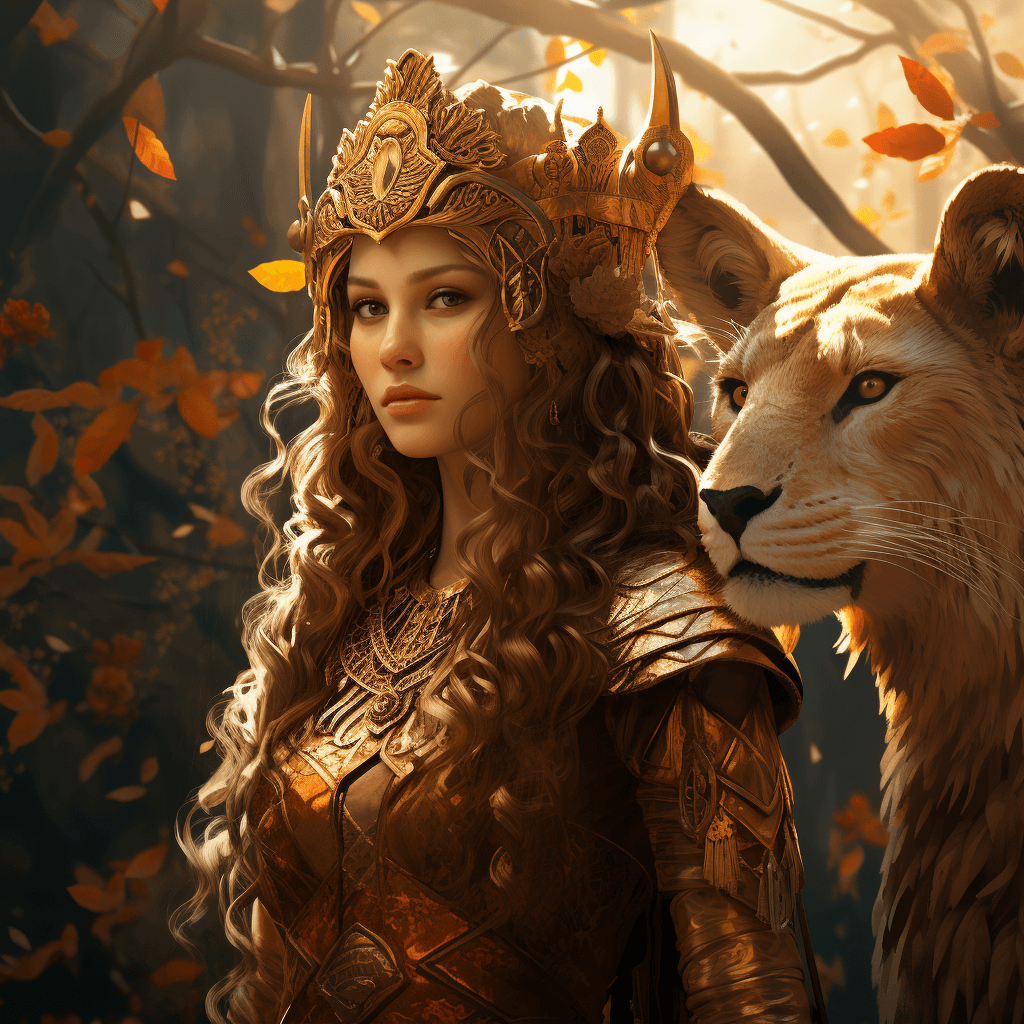
Among the many intriguing facets of Artemis, her bond with the wilderness and its inhabitants stands out prominently. As the guardian of forests, mountains, and meadows, it’s no surprise that Artemis is often portrayed surrounded by a retinue of nymphs and a host of animals. Let’s journey into the wild terrains of ancient Greek myths and explore the vibrant world of Artemis’s companions.
The Nymphs: Ethereal Maidens of Nature
Often seen flanking the goddess in art and literature, the nymphs, as ethereal maidens, were intrinsically linked to nature’s elements. From the echoing cries of the Oreades (mountain nymphs) to the soft whispers of the Dryades (tree nymphs), these divine entities represented various facets of the wild.
- Naiades – Water nymphs residing in freshwater bodies, from springs to lakes. Their bond with Artemis signified the goddess’s protective stance over all water sources in the wilderness.
- Nereides – Sea nymphs who, though primarily associated with the oceans, also symbolized the interconnectedness of nature.
- Hyades – Nymphs of rain and clouds, they represented the refreshing showers that rejuvenate the wild.
Animals of the Wilderness: Symbols of Sacred Purity
Animals were more than mere creatures in the realm of Artemis. They were sacred symbols, emblematic of purity, strength, and freedom. Among the myriad creatures, a few held a special place beside the goddess:
- Deer: Often depicted with a golden-horned hind, the deer symbolized purity and innocence, mirroring Artemis’s own eternal maidenhood.
- Bears: Powerful and fierce, bears denoted strength and motherhood. Ancient rituals involving young girls “playing the bear” for Artemis trace back to this association.
- Wolves: As creatures of keen instincts, they represented the sharp, hunter aspect of Artemis, emphasizing her role as the protector of the wilderness.
The Bond Beyond Divinity
Why did these companions hold such a revered space beside Artemis? The companionship between Artemis and her entourage was not just about divine associations; it was a depiction of harmony. Artemis, with her nymphs and animals, painted a picture of an ecosystem in balance, where divinity mingled seamlessly with nature’s rhythm.
Artemis’s relationship with her companions accentuates her role as the guardian of nature, highlighting the profound respect ancient Greeks held for the wilderness. Through her, the intertwining relationships between the divine, humans, and nature found a harmonious representation, urging us to cherish and protect the natural world around us.
Roles Beyond the Hunt: Artemis as the Goddess of Childbirth and Protector of the Young
When we envision Artemis, it’s easy to be captivated by her prowess as the Huntress, her silhouette adorned with a quiver and bow. However, delving deeper into the labyrinth of Greek mythology reveals a multi-dimensional goddess. Not only was Artemis the indomitable force of the wild, but she also bore significant responsibilities as the guardian of childbirth and the young. Let’s embark on a journey to uncover this lesser-known facet of the goddess.
The Dual Nature: Virginity and Childbirth
It’s a conundrum that fascinates many: How could Artemis, the eternal virgin, be associated with childbirth? The paradox lies in the ancient Greeks’ perception of virginity. For them, virginity was a symbol of independence and autonomy, and not merely a physical attribute. In her capacity as an autonomous deity, Artemis presided over the critical moments of life, ensuring the safe transition of women into motherhood.
Protector of the Vulnerable
- Guardian of Infants: Newborns were incredibly vulnerable in ancient times. Artemis, with her nurturing aspect, was invoked to shield these young souls from harm.
- Patron of Young Girls: As girls navigated the bridge between childhood and womanhood, Artemis became their beacon. She was seen as the divine figure guiding them through rites of passage, ensuring their safety and well-being.
- Defender of Wildlife Offspring: In the wild terrains, young animals face myriad threats. Given Artemis’s intrinsic connection with wildlife, she was their celestial protector, ensuring their growth and survival.
Ilithyia: The Goddess of Childbirth
While Artemis’s association with childbirth might seem unexpected, another deity, Ilithyia, further cements this role. Ilithyia, often identified with or as an aspect of Artemis, was explicitly worshiped as the goddess of childbirth. Ancient texts and hymns often invoked Ilithyia’s favor to ensure the smooth delivery of a child and the safety of the mother.
Embracing the Dual Roles
The juxtaposition of Artemis as both the huntress and the guardian of childbirth showcases the depth and versatility of Greek deities. It underscores the idea that life is a spectrum of experiences, and divinity is no exception. In Artemis, we find a harmonious blend of strength and nurture, of fierce independence and gentle care.
As we reflect on Artemis’s multifaceted nature, it becomes evident that she is not just the goddess of the hunt but also a symbol of the many roles women play, transcending boundaries and defying singular definitions.
Festivals and Games: Celebrations in Honor of the Huntress Goddess
Amidst the myriad tales and depictions of Artemis, an intriguing facet remains her powerful influence on the cultural and religious celebrations of ancient Greece. Festivals and games, awash with excitement, athleticism, and reverence, were organized in her honor, solidifying her imprint on the Grecian societal tapestry. Join us as we journey back in time, exploring these captivating celebrations dedicated to the Huntress Goddess.
Artemisia: The Annual Festival
The most notable celebration in honor of Artemis was the Artemisia, an annual festival observed with great zest. It wasn’t just a tribute to the goddess’s hunting prowess, but also her roles as the protector of young women and nature.
- Dance of the Bears: Young girls, dressed in saffron-colored robes, performed the iconic “Bear Dance”. This was a nod to the legend of Callisto, a nymph transformed into a bear, who was then placed among the stars by Artemis.
- Sacred Hunts: A ritualistic hunt was organized, symbolizing Artemis’s dominion over the wild. It was less about the chase and more about paying homage to the wilderness.
Brauronia: Honoring Artemis Brauronia
In the region of Brauron, a unique version of Artemis, known as Artemis Brauronia, was venerated. Here, festivities were particularly focused on the transition of girls to womanhood.
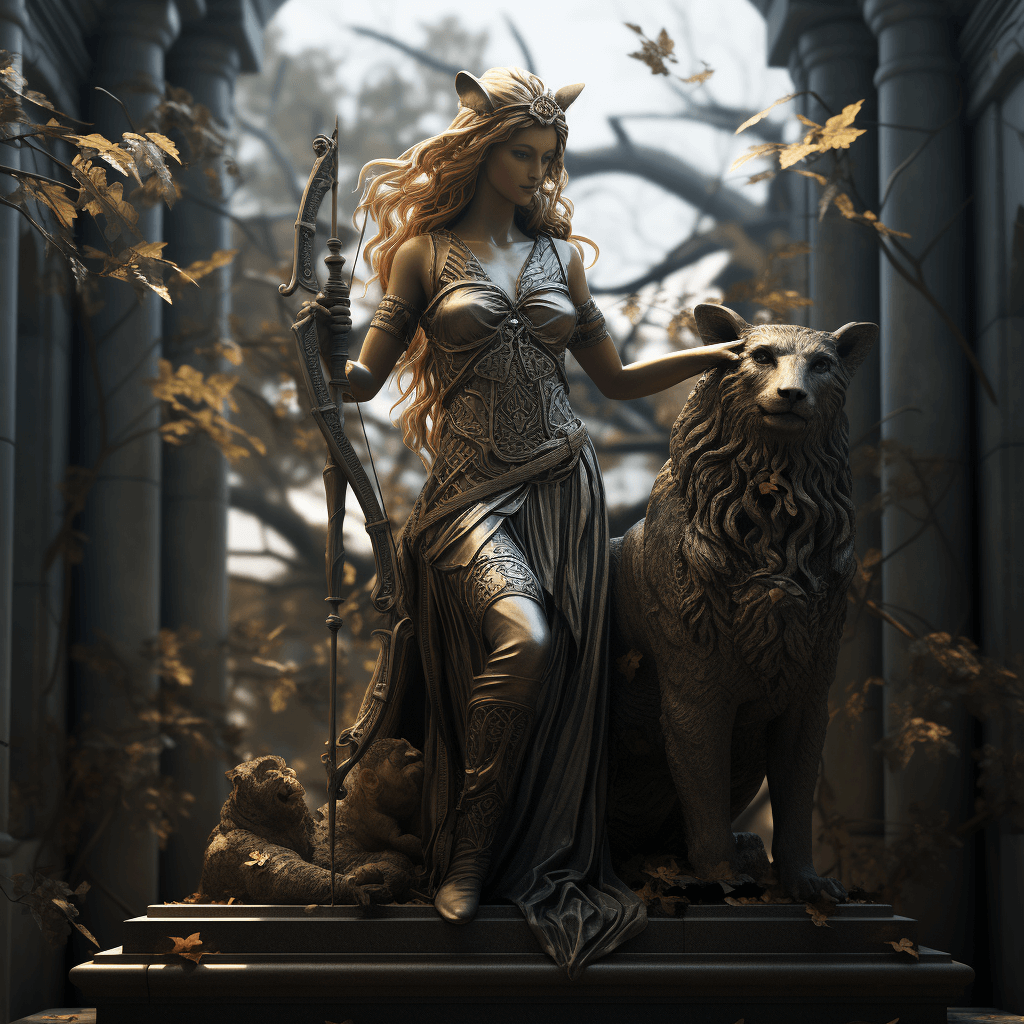
- Robes Offering: Young girls, before their marriage, would dedicate their childhood robes to the goddess, symbolizing the transition to adulthood.
- The Great Procession: A grand procession from Athens to Brauron was organized every four years, with a sacred statue of Artemis carried to its sanctuary.
The Elaphebolia: The Deer Hunt Festival
Artemis’s association with the deer was celebrated during the Elaphebolia. Participants would craft cakes in the shape of stags and does. While it was primarily a tribute to her hunting aspect, it also subtly acknowledged her nurturing nature towards gentle creatures.
Games in the Goddess’s Honor
Athletic games, mirroring the Olympic Games, were also organized in various sanctuaries of Artemis. These weren’t just a display of physical prowess but were also imbued with religious undertones, ensuring the participants competed with both vigor and reverence.
Exploring these festivals and games deepens our understanding of Artemis’s influence. It wasn’t just about worship; it was about integrating her teachings and values into everyday life, celebrating both the wild and the nurturing facets of the formidable Huntress Goddess.
Artemis’s Influence in Literature and Arts: From Ancient Texts to Modern Media
As with many figures of ancient mythology, Artemis’s sphere of influence hasn’t been limited to tales of old. Her iconic status has permeated artistic endeavors across eras, inspiring generations of poets, playwrights, sculptors, and even modern filmmakers. Diving deep into this cultural trove, we uncover the Huntress Goddess’s lasting legacy in both the classical and contemporary domains of literature and arts.
Classical References: The Homeric Hymns and Tragedies
In The Homeric Hymns, a collection of poems dedicated to Greek deities, Artemis’s birth, her youthful exploits, and her fierce nature are vividly depicted. Playwrights like Euripides and Aeschylus have incorporated her essence into their tragedies, presenting multi-faceted views of the goddess – sometimes as the unyielding huntress, at other times as the protector of the innocent.
The Renaissance Period: Artistic Revival
The European Renaissance witnessed a revival in interest for Greek mythology. Artists and sculptors, captivated by the tales of Artemis, incorporated her symbolisms into their masterpieces. Whether it’s Titian’s Diana and Actaeon or Rembrandt’s Artemis as Diana, her ethereal presence was profoundly captured in canvases and stone.
Modern Literature: From Fantasy to Non-fiction
Modern authors have not been impervious to Artemis’s allure. From Rick Riordan’s Percy Jackson series, where she leads a band of immortal huntresses, to non-fiction works discussing her influence, the spectrum of references is vast. One could wonder, what is it about Artemis that resonates even in contemporary narratives?
Modern Cinema and Television
Artemis’s leap into modern media is a testament to her timeless charm. Films have reimagined her in various avatars, blending her ancient traits with contemporary contexts. Television series, while often taking creative liberties, have succeeded in introducing the goddess to newer audiences, ensuring her tales remain evergreen.
Poetic Representations
Many poets, enticed by Artemis’s multifaceted nature, have penned verses dedicated to her. They often juxtapose her wilderness with her nurturing demeanor, crafting verses that are both evocative and contemplative. After all, how does one capture the essence of a goddess so wild, yet so caring?
In sum, Artemis’s indelible mark on the literary and artistic realms is undeniable. As generations evolve and mediums change, one thing remains constant: the fascination and reverence for the Huntress Goddess. Through words, strokes, and frames, her legacy continues, reminding us of her unparalleled spirit and her place in the annals of culture and art.
Comparative Mythology: Artemis and her Counterparts in Other Cultures
The vast tapestry of global mythologies often presents intriguing parallels, with deities from distinct cultures bearing remarkable resemblances in their roles and attributes. Artemis, the revered Huntress Goddess of ancient Greece, is no exception. By delving into comparative mythology, we can discover similar divine figures across various civilizations, reflecting universal human themes and shared ancient narratives.
The Roman Diana: A Direct Parallel
Perhaps the most direct counterpart to Artemis is the Roman goddess Diana. Like Artemis, Diana was venerated as the virgin goddess of the hunt and wild animals. She also held dominion over childbirth and nature, weaving a tapestry of similarities with her Greek counterpart. The reverence and rituals for Diana, especially at her sacred grove in Nemi, mirror the worship of Artemis in many ways.
Ullr of Norse Mythology
From the snow-sprinkled landscapes of Scandinavia comes Ullr, a god associated with archery and winter sports. Though male, Ullr’s connection with the hunt and his expertise with the bow draw unmistakable parallels with Artemis’s characteristics.
The Hindu Goddess Durga
Moving towards the Indian subcontinent, we encounter Durga, a fierce goddess who, much like Artemis, is depicted with a weapon – in this case, a trident – and is often shown riding a lion, symbolizing her mastery over the wild. Durga’s tales of vanquishing demons and protecting the natural world resonate with Artemis’s role as a guardian of the wilderness.
The Egyptian Bastet
Shifting our gaze to ancient Egypt, Bastet, originally a lioness warrior goddess, underwent a transformation to become the cat goddess, protector of homes. Her duality, both fierce and nurturing, offers an interesting comparison to Artemis’s multifaceted nature.
- Diana – Roman counterpart, sharing nearly identical roles.
- Ullr – Norse god of archery and hunt.
- Durga – Hindu goddess with a protective, combative nature.
- Bastet – Egyptian deity showcasing duality.
In observing these counterparts, what becomes evident is the universality of certain divine archetypes. Whether it’s the fierce protector, the masterful huntress, or the guardian of the wild, these themes find echoes across the ages and continents. And while each culture imbues its deities with unique stories and traits, the essence remains strikingly consistent.
This comparative exploration not only enhances our appreciation for Artemis but also underscores the interconnectedness of human societies. Through the lens of mythology, we witness the shared aspirations, fears, and values that shape civilizations, beautifully manifested in their divine tales and figures.
Frequently Asked Questions
Why is Athena the goddess of wisdom?
Athena, according to Greek mythology, sprang fully grown and armored from the forehead of her father Zeus. As a deity born in such a unique manner, she was deemed the embodiment of her father’s intellect and wisdom. Throughout various myths, Athena’s wisdom manifests in her role as a mentor, strategist, and even peacemaker, making her the epitome of divine knowledge and prudence in the Greek pantheon.
What does Artemis hunt?
Artemis is renowned as the goddess of the hunt, wilderness, and wild animals. In myths, she is often depicted hunting deer and other woodland creatures. However, her dominion extends beyond mere animals; she also oversees the vast landscapes of forests and mountains.
What are 3 facts about Artemis?
- Artemis is the twin sister of Apollo, the sun god, and she is often associated with the moon.
- She took a vow of perpetual virginity and was also the protector of young girls until they married.
- Artemis is sometimes associated with the cypress tree and animals like the deer and the bear.
Why is Artemis a big deal?
Artemis holds significant importance in Greek mythology as the goddess of the hunt, wilderness, and childbirth. She symbolizes independence, protection, and strength. As one of the twelve Olympian deities, her influence was vast, and she was widely worshipped throughout ancient Greece. Her multifaceted roles in various myths highlight her prominence in the pantheon.
Who did Artemis turn into a girl?
Artemis transformed the Cretan boy Siproites into a girl because he accidentally saw her bathing. This transformation was a response to preserve her vow of virginity and her desire for privacy.
Is Artemis the most powerful goddess?
While Artemis is immensely powerful, especially in domains related to hunting, wilderness, and childbirth, the title of “the most powerful goddess” is subjective and varies based on myths and regions. Each goddess in the Greek pantheon has her own unique strengths and domains. However, Artemis’s vast array of responsibilities and her widespread worship showcase her significance and power.
Who does Artemis love?
Artemis, unlike many other Greek gods and goddesses, did not have many romantic liaisons. She took a vow of eternal virginity. However, there are myths that speak of her close relationships and affections for her hunting companions and the nymphs. One such story revolves around her deep affection for Orion, although versions of this story vary widely.
Is Artemis evil?
Artemis is not considered “evil” in Greek mythology. Like all deities, she possesses complex characteristics and acts based on her domains and the values she upholds. While she is a protector and nurturer, she can also be fierce and vengeful, especially when her values, such as her vow of virginity, are threatened. Her actions are better understood as manifestations of her roles and principles rather than a binary concept of good or evil.
Discover the Greek Gods and Goddesses
Venture into the stories of Greek gods and goddesses with our brief guide. Learn more by exploring the links below.

